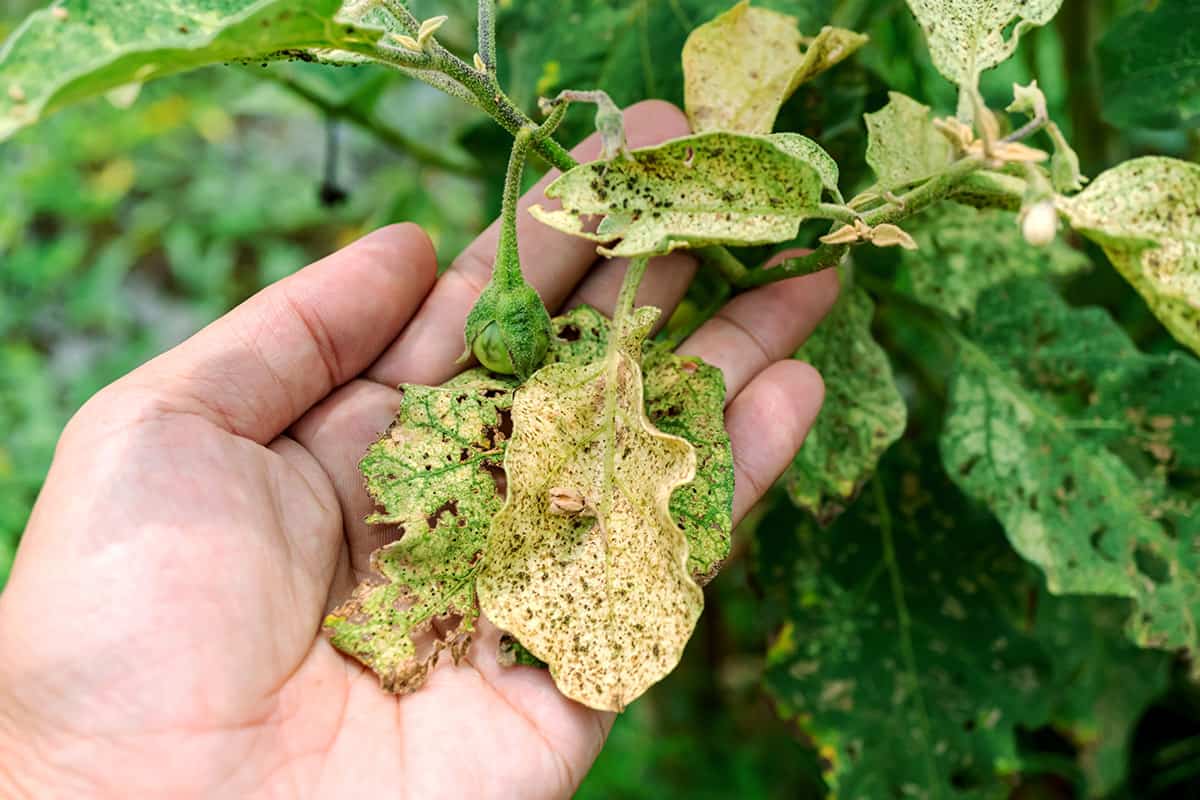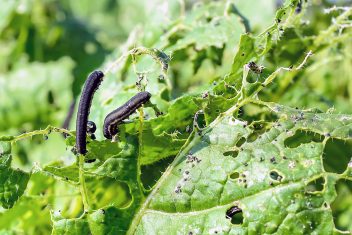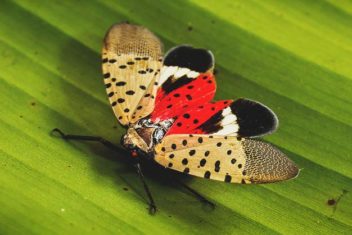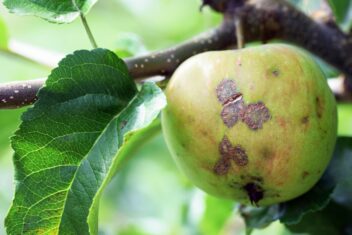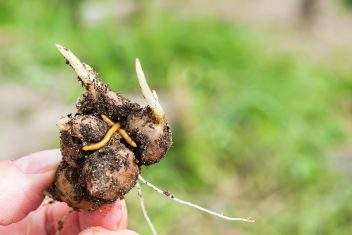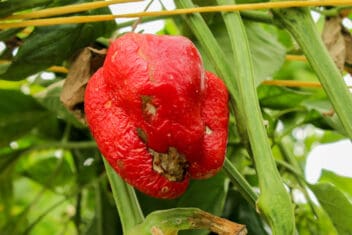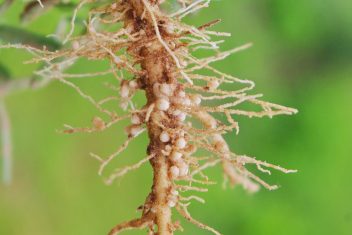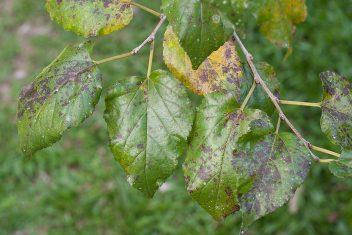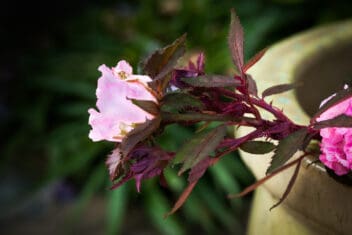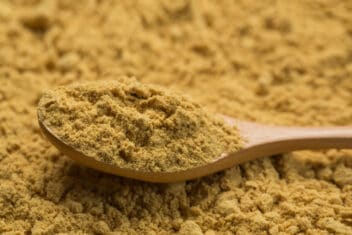Eggplants belong to the nightshade family, along with tomatoes, peppers, and potatoes. Like their plant cousins, they can be prolific and extremely tasty. But, like other nightshades, eggplants are also subject to a number of irritating pests and diseases.
Whether your plant is already sick or you’re trying to head off any problems, it’s important to know what you’re facing. That’s why learning what insects and diseases eggplants will help you keep your garden healthy. There’s no time to waste, so let’s dive right in.
6 Eggplant Pests
Many eggplant pests are the same ones that your tomato or potato plants face. If you’ve ever dealt with aphids or hornworms, then you know what you’re dealing with.
1. Aphids
Aphids are small, soft-bodied insects that stick to the underside of leaves and the stems of plants. Their colors vary from green and yellow to pink and brown, depending on the host plant. In eggplant, the cotton aphid (Aphis gossypii) and the green peach aphid (Myzus persicae) are most common. The former can be yellow, green, or nearly black, while the latter is yellow or green.
Small infestations rarely cause problems, but heavy aphid infestations will cause the leaves to turn yellow and necrotic spots on the leaves to develop.

The real problem with aphids on eggplants is that they secrete a sticky, sugary substance called honeydew that encourages sooty mold to develop on your plants. They can also spread diseases.
Check out our guide to aphids on your garden plants.
2. Colorado Potato Beetle
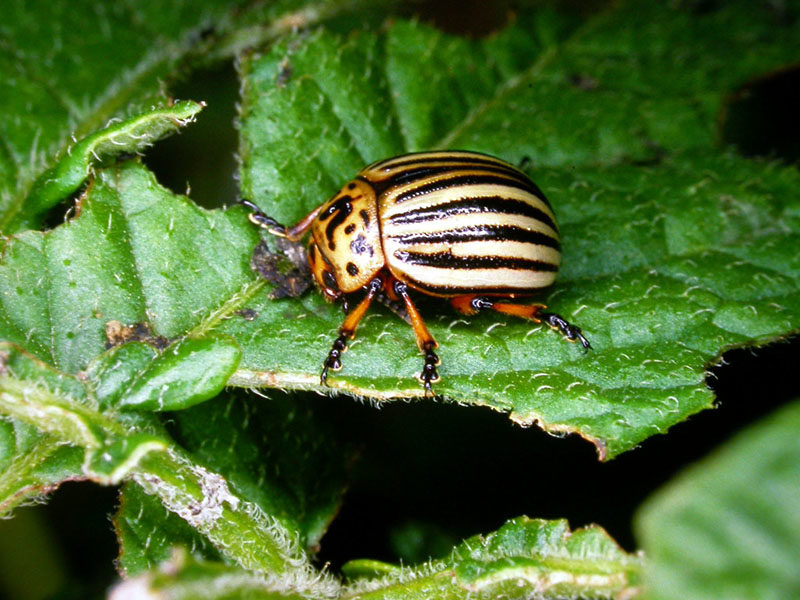
Don’t let the name fool you; Colorado potato beetles (Leptinotarsa decemlineata) infect more than potato plants (and they don’t just live in Colorado). These pests are a serious problem for all plants in the nightshade family.
Colorado potato beetles feed on the foliage of the plants, causing serious damage. Severe infestations completely defoliate plants. Controlling these pests is difficult because they have developed a high level of insecticide resistance.
Applying Bacillus thuringiensis is one way to control the larvae. It has to be applied frequently, but it’s not harmful to the environment. Insecticides that contain spinosad are effective against the adult Colorado potato beetles.
3. Cutworms
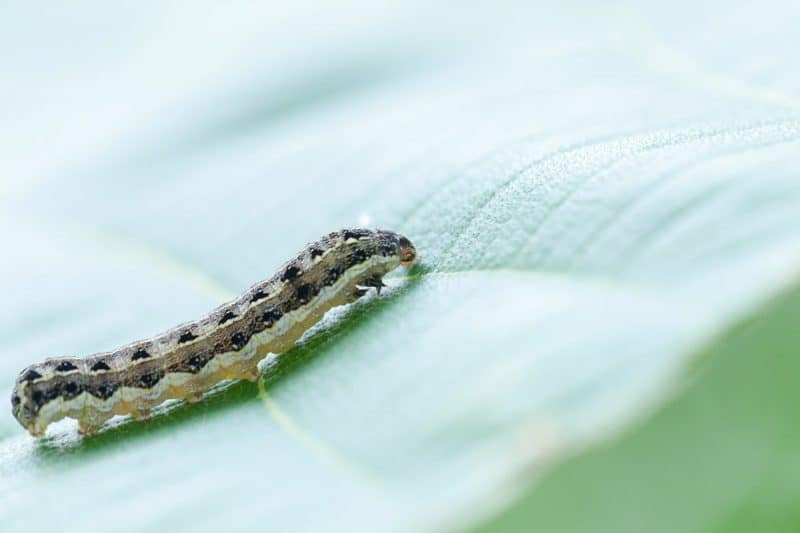
Cutworms (Noctuidae spp.) are a frustrating pest to deal with in your garden, and they love eggplants. They chew through the stems of young seedlings, severing them at the soil line. They’re most active at night, so it’s easy to miss them in your garden.
Cutworms infect more than eggplants; they love tons of veggie crops in your garden. Getting rid of cutworms is possible, but you have to be diligent. You’ll need to use a few techniques like hand-picking the larvae at night and spreading diatomaceous earth around the base of your plants to curb a cutworm infestation.
4. Flea Beetles
Flea beetles are leaf-eating beetles in the Chrysomelidae family, and they’re a frustrating eggplant pest. They cause small holes or pits in the leaves that can stunt growth. Seedlings and young plants are most vulnerable to these pests. Flea beetles can cause severe damage to plants, and they eventually feed on the fruits of the eggplants, ruining your harvest.
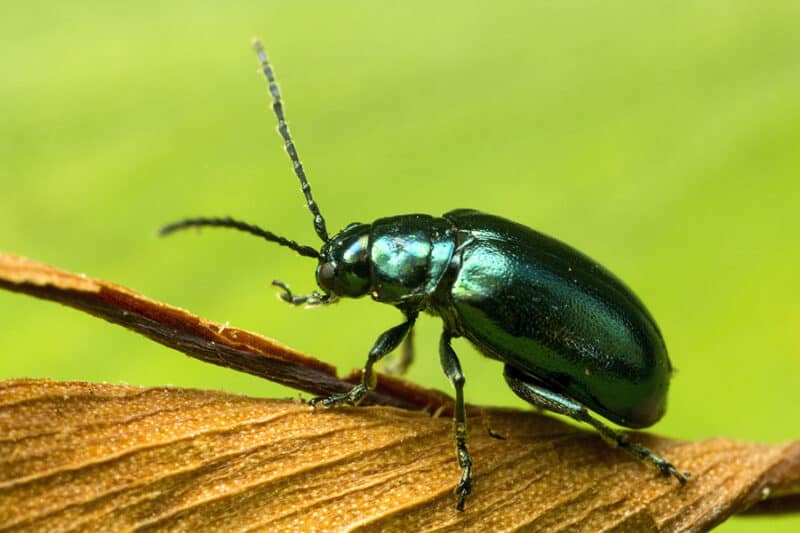
Plus, they spread diseases!
Covering your young eggplant seedlings with floating row covers is one way to prevent flea beetles from taking over your plants. Many preventative measures work well, so be sure to use those before these pests find your garden.
If you end up with flea beetles in your garden, some measures work to control their population. Insecticides that contain spinosad, permethrin, and carbaryl control these pests the best, but other organic methods work as well.
5. Hornworms
Two common types of hornworms might infect your eggplants: tomato (Manduca quinquemaculata) and tobacco hornworms (Manduca sexta). These pests are huge and cause massive damage to the leaves of your plants. Heavy infestations cause damage to the fruits as well.
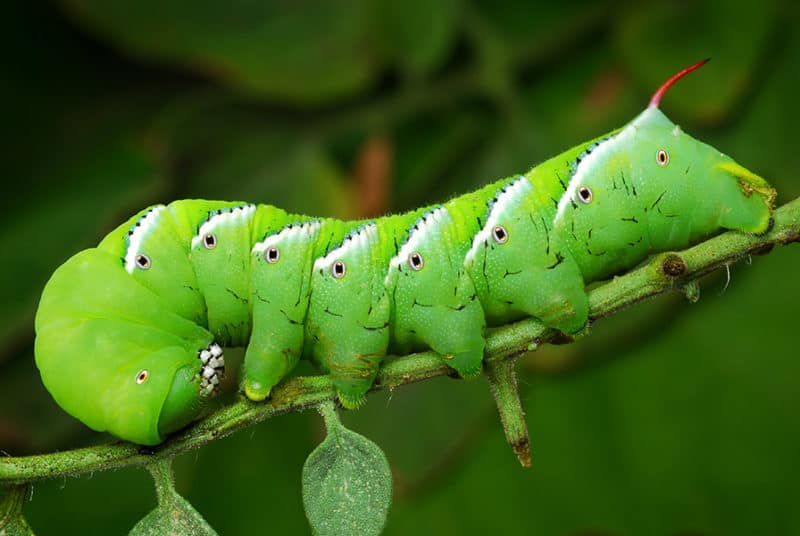
Most people are familiar with tomato hornworms, but tobacco hornworms look almost identical. They both reach up to three or four inches in length and have a horn at the end of their bodies.
Getting rid of these pests is totally possible. Start by making sure you inspect your plants regularly for any holes in the leaves or the worms themselves, because an infestation happens quickly.
6. Stink Bugs
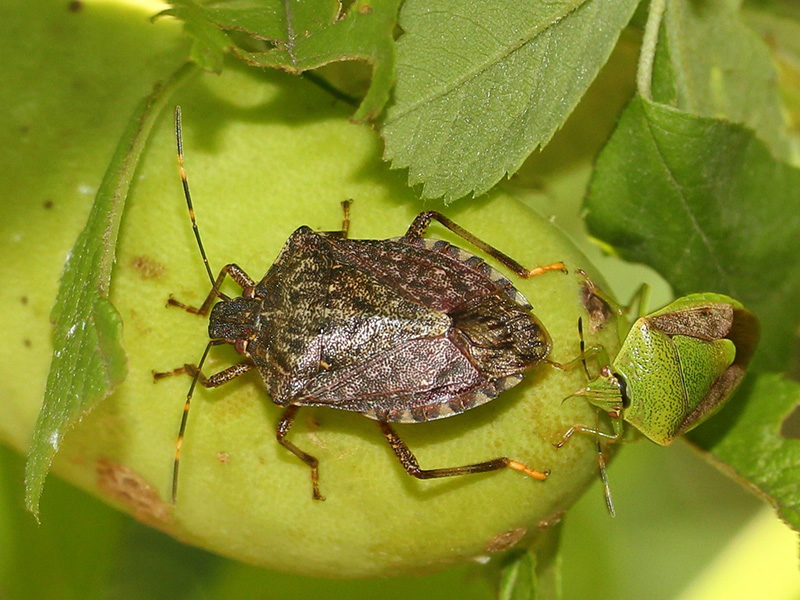
Most people assume that stink bugs (Acrosternum hilare) are those annoying little black beetles that spray a foul odor when disturbed. But the stink bug we’re talking about is a one with a shield-shaped back that attacks plants in the nightshade family.
Stink bugs cause dark-colored pinpricks that eventually turn yellow on the fruits. They also carry pathogens that cause secondary infections and the decay of fruits.
Removing weeds near your eggplants helps prevent these pests because weeds and debris create areas for stink bugs to overwinter. Insecticidal soaps, kaolin clay, and introducing natural enemies are different ways to get rid of stinkbugs in the garden.
7 Eggplant Diseases
If you find yourself facing one of these eggplant diseases, don’t panic. Most of these are treatable and won’t kill your garden plants if you catch them early enough.
1. Anthracnose Fruit Rot
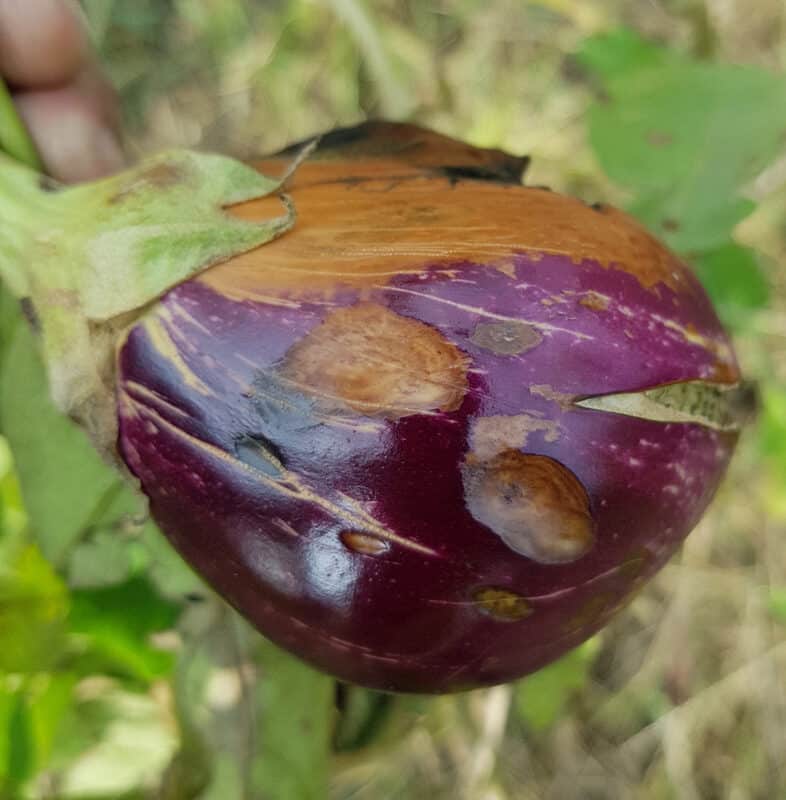
Anthracnose is a fungal disease (Colletotrichum coccodes) that doesn’t always cause symptoms, but when it does, it starts small with small, sunken spots on the fruits of your plants. Over time, the spots merge into much larger blotches.
Over time, the spores set and circles cover the lesions along with an orange or pinky jelly-like patch covers the lesions.
Removing infected fruits from your plants is vital if you suspect this fungal disease. Here is our guide to anthracnose in the garden.
2. Blossom-End Rot
Eggplants and tomatoes are in the same plant family, so it’s no surprise that they both can end up with blossom end rot. You’ll notice small, water-soaked areas on the ends of the fruits where the blossom was when unripened. Gradually, the lesions enlarge, turn black and leathery in appearance.
Blossom-end rot is caused by low calcium concentrations in the fruit that might come from the competition with other plants in the garden. However, it’s caused by other problems, like drought stress.
Learn more about blossom-end rot in our guide to handling this problem in your garden.
3. Cercospora Leaf Spot
Cercospora leaf spot is a fungal pathogen (Cercospora melongenae) that appears on the lower part of the plant in the beginning and moves up the plant gradually. You might notice small circular spots on the leaves that are light to dark brown, and over time, the lesions expand.
Badly infected leaves dry out and curl, eventually dropping off the plant. That’s one of the problems because the fungus will survive the winter on debris that drops onto the soil.
Treating Cercospora leaf spot is difficult, but it’s possible to prevent it. Spacing plants appropriately and giving them room for proper airflow is important, and you should always irrigate at the base of plants.
If your eggplant plants still end up with Cercospora leaf spots, applying fungicides can help decrease the fungus on your plants. However, don’t expect the fungal disease to go away entirely.
4. Damping Off
One of the most common eggplant diseases that infect seedlings is damping off. It’s caused by pathogens in the Phytophthora, Pythium, and Rhizoctonia genera. Infected seedlings fail to fully emerge, and the seedlings might end up with light brown to red soaked roots and stems. Damping-off causes seedlings to collapse, dry up, and die.
Treating damping off is difficult if not impossible in most cases. Check out our guide to damping off in your garden.
5. Early Blight
If you notice the premature dropping of lower leaves on your eggplants, you might have early blight. This fungus (Alternaria solani) causes brown-black spots on the leaves that cover the leaf surfaces. They might also have alternating rings of light and dark on the leaves.
Over time, early blight causes large, sunken areas and a black velvety texture on the stem end of the fruit. This fungus spreads rapidly after plants set fruit, but fungicide applied at the first sign of the disease may be effective.
6. Powdery Mildew

Another fungal disease that infects eggplants is powdery mildew. Various fungi such as Erysiphe spp. and Sphaerotheca spp. cause white, powdery spots on the leaves, shoots, flowers, and fruits. They might also cause yellow, twisted leaves that eventually drop off the plants.
Powdery mildew likes shady conditions that have poor air circulation. Take a look at our guide to powdery mildew in the garden.
7. Verticillium Wilt
Verticillium wilt is another fungal pathogen (Verticillium dahliae)that appears on eggplants. The first symptoms starts on the lower leaves and spread upward; you’ll notice yellow blotches on the lower leaves, rapid yellowing, and rolling leaf edges.
One of the biggest problems with verticillium wilt is that it survives in the soil indefinitely. It comes out during cool temperatures in the spring, and controlling this fungus is hard. You will need to solarize the soil to protect your plants.
Here is our guide to verticillium wilt.
